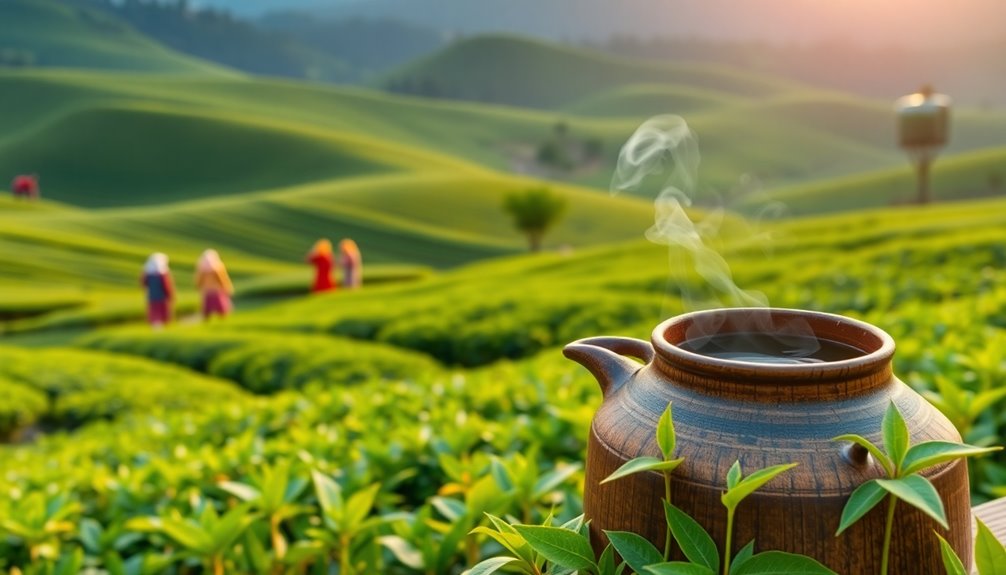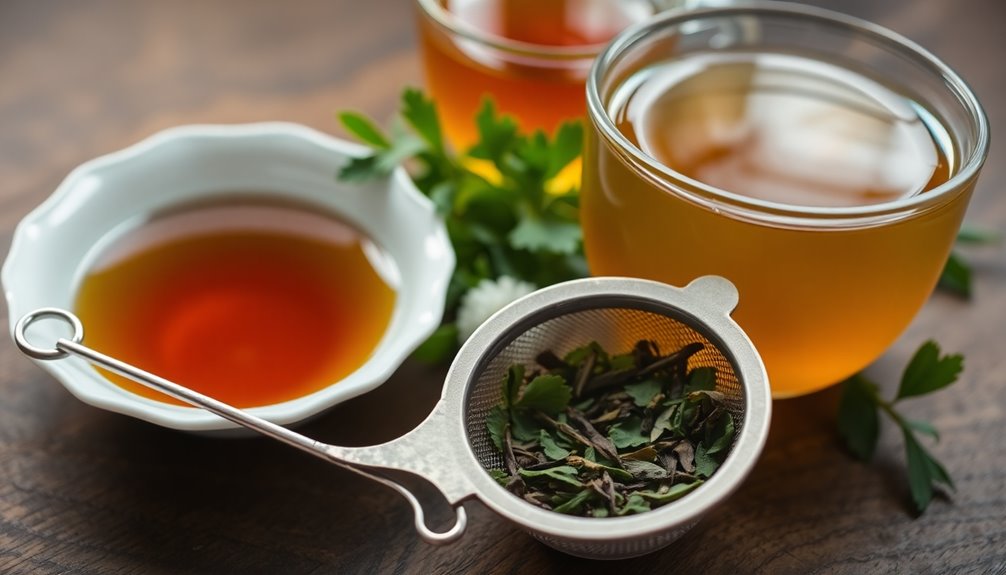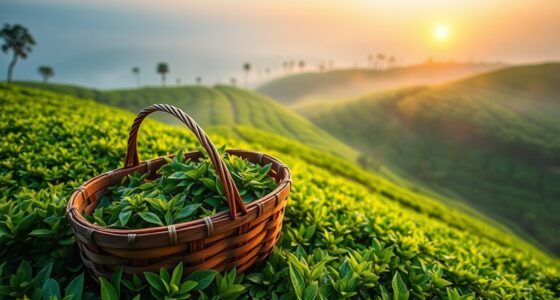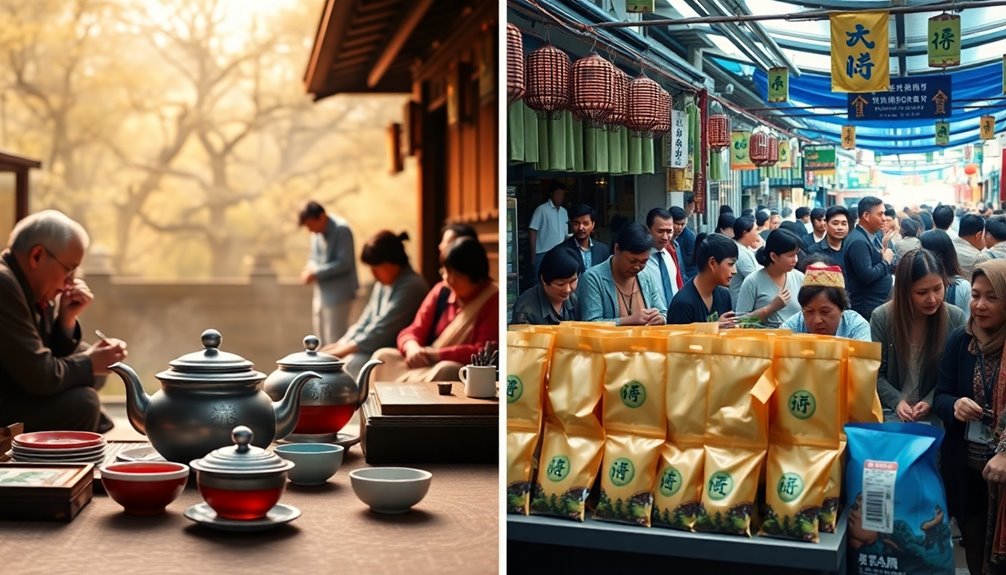You might be surprised to learn that tea’s journey began over 5,000 years ago in ancient China, where it was first used as a medicinal drink. As it spread across cultures, it became central to social customs, from China’s elaborate ceremonies to Britain’s charming afternoon tea. The British East India Company played a significant role in global tea trade, shaping both economics and diplomacy. Today, tea encourages community connections and underscores sustainability practices. From health benefits to cultural rituals, tea’s rich legacy continues to evolve. There’s even more to uncover about its impact through history.
Key Takeaways
- Tea was discovered in ancient China over 5,000 years ago, initially used for medicinal purposes before evolving into a cultural staple.
- The British East India Company played a crucial role in the global tea trade, establishing cultivation methods and monopolizing imports during the colonial era.
- Various cultures developed unique tea practices, such as Chinese ceremonies and British afternoon tea, reflecting social customs and community bonding.
- Health benefits of tea, including antioxidants and anti-inflammatory properties, have contributed to its enduring popularity and diverse consumption worldwide.
- Contemporary tea cultivation emphasizes sustainability, with ethical sourcing and organic practices gaining traction in response to consumer demand for eco-friendly products.
Introduction

Tea, a beloved beverage enjoyed worldwide, has a rich and fascinating history that dates back over 5,000 years. It all began in ancient China, where Emperor Shen Nong discovered tea when leaves accidentally fell into his boiling water. This serendipitous moment set the stage for tea’s rise to cultural significance, particularly during the Tang Dynasty (618–907 CE). Here, it became intertwined with poetry, art, and intricate ceremonies.
By the 16th century, tea began its journey to Europe through Portuguese traders, eventually capturing the hearts of the British aristocracy after Charles II married Catherine of Braganza. The British East India Company played a pivotal role in tea importation and cultivation, establishing renowned tea regions like Assam and Darjeeling.
Today, tea has evolved into a global phenomenon, with annual consumption exceeding 6 billion kg by 2020. It remains a cherished beverage, often enjoyed during social gatherings and rituals across various cultures.
This rich history not only celebrates tea as a drink but also highlights its enduring impact on social customs and connections throughout the ages.
Cultural Significance Across Continents

Throughout the world, tea holds a unique cultural significance that varies from region to region. In China, tea culture blossomed during the Tang Dynasty, where Chinese tea became a symbol of status and elegance, leading to intricate tea ceremonies that emphasize harmony and tranquility.
Meanwhile, the Japanese tea ceremony, or Chanoyu, introduced by Buddhist monks, reflects Zen principles and has been refined over centuries to embody grace and mindfulness.
In the Middle East, robust black tea, particularly mint tea, symbolizes hospitality and social bonding. It’s often served during gatherings as a heartfelt gesture of welcome.
Moving to Britain, the tradition of afternoon tea, established by Anna, Duchess of Bedford, transformed tea into a significant social event, featuring light snacks and encouraging connections among the upper class.
In India, Masala Chai showcases the diverse regional variations of chai culture, where tea serves as more than just a beverage; it’s a daily ritual that unites people across different social settings.
Each of these traditions highlights tea’s role in fostering relationships, making it a cherished element in cultures worldwide. Additionally, various flower teas, such as Hibiscus tea, are often integrated into cultural practices for their health benefits and vibrant flavors.
Global Tea Consumption Trends
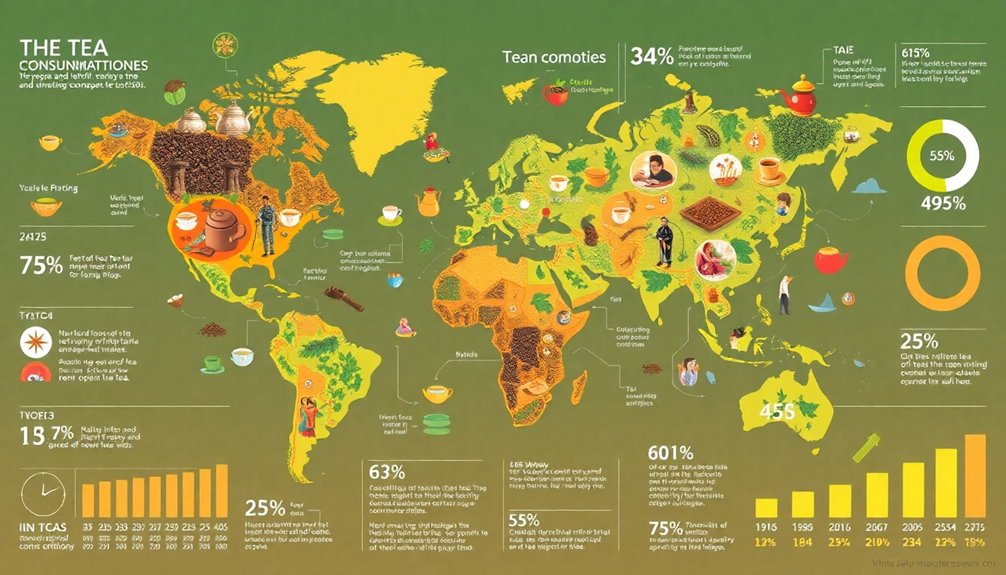
With a staggering 6 billion kilograms consumed annually by 2020, the global tea market showcases its immense popularity and cultural significance.
You’re witnessing a dynamic shift in tea consumption patterns, with major players like China and India leading the charge. India, boasting over 13,000 tea gardens, stands as the world’s second-largest tea producer. Here, black tea reigns supreme, while green tea continues to grow in popularity.
As you explore the evolving landscape of tea, you can’t ignore the surge in iced tea consumption. This refreshing alternative has become a favorite among consumers, especially during warmer months. Instant tea has also made its mark, catering to busy lifestyles and offering a quick solution for those on the go.
The British have long been associated with tea drinking, but today, tea consumption spans cultures and continents, adapting to local preferences and trends.
Whether you’re sipping a classic cup of black tea, enjoying the lightness of green tea, or opting for the convenience of instant tea, you’re part of a global movement that celebrates this cherished beverage.
Embrace the diversity of tea as it continues to evolve in the global tea market.
Tea’s Role in Global Diplomacy
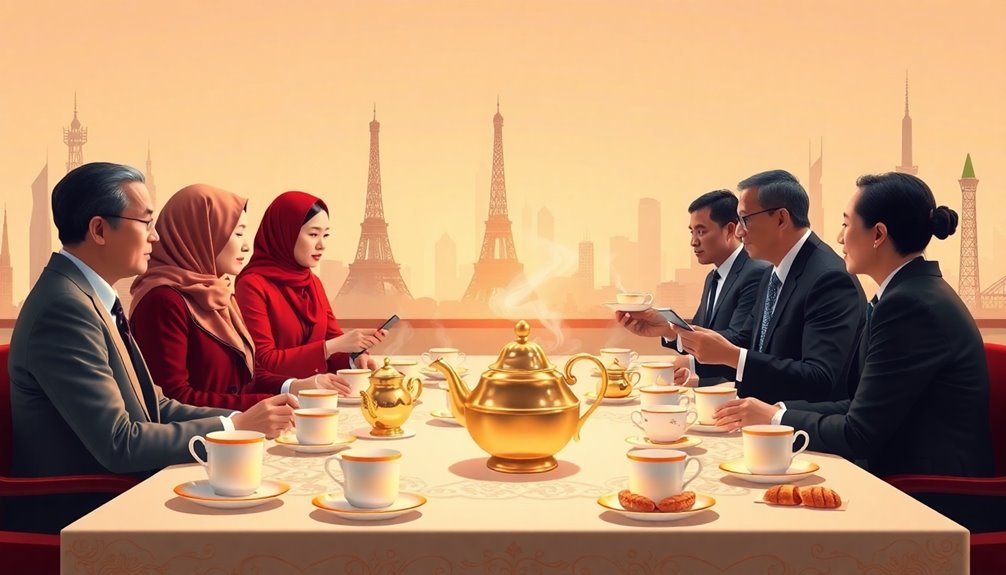
In the rich tapestry of global interactions, tea has carved out a unique niche as a medium of diplomacy. The British East India Company played a crucial role in establishing political relations between Britain and China during the 17th and 18th centuries, with tea serving as the catalyst.
However, the Opium Wars (1839-1842 and 1856-1860) complicated these interactions, showcasing how tea’s trade intertwined with opium, altering power dynamics drastically. The signing of the Treaty of Nanking in 1842, which ended the First Opium War, granted Britain favorable trade rights and marked the start of a challenging era for China, illustrating tea’s profound impact on international relations.
Fast forward to the Cold War, where tea diplomacy emerged as a strategic tool. Nations leveraged this beloved beverage to foster goodwill and cultural exchange, exemplified by the notable “Tea Talks” between the United States and China in the 1970s.
Even today, tea continues to serve as a diplomatic instrument, with countries hosting tea ceremonies or exchanging tea as gestures of friendship, enriching the legacy of tea in global diplomacy.
Colonial Exploitation of Tea Trade

Tea’s journey through colonial exploitation reveals the darker side of its global popularity. The British East India Company established a monopoly over the tea trade in the 17th century, controlling imports and pricing, which shaped global tea markets.
As the demand for tea skyrocketed, the Company turned to India, particularly Assam, to boost tea production. This led to the exploitation of local labor, as workers faced harsh working conditions with little economic benefit.
After the East India Company’s monopoly was abolished in 1834, individual merchants seized the opportunity, and tea exports from India surged, eventually surpassing imports from China by 1888.
However, this boom came at a cost. Colonial policies prioritized profit over worker welfare, forcing local laborers into grueling environments with minimal pay.
Amidst high taxation imposed by the British government, smuggling emerged as a response, with organized crime networks illegally importing millions of pounds of tea.
This contentious dynamic underscored the moral complexities of the tea trade, as the pursuit of profit overshadowed the lives of those who cultivated and harvested the very leaves that fueled global consumption.
Practical Applications
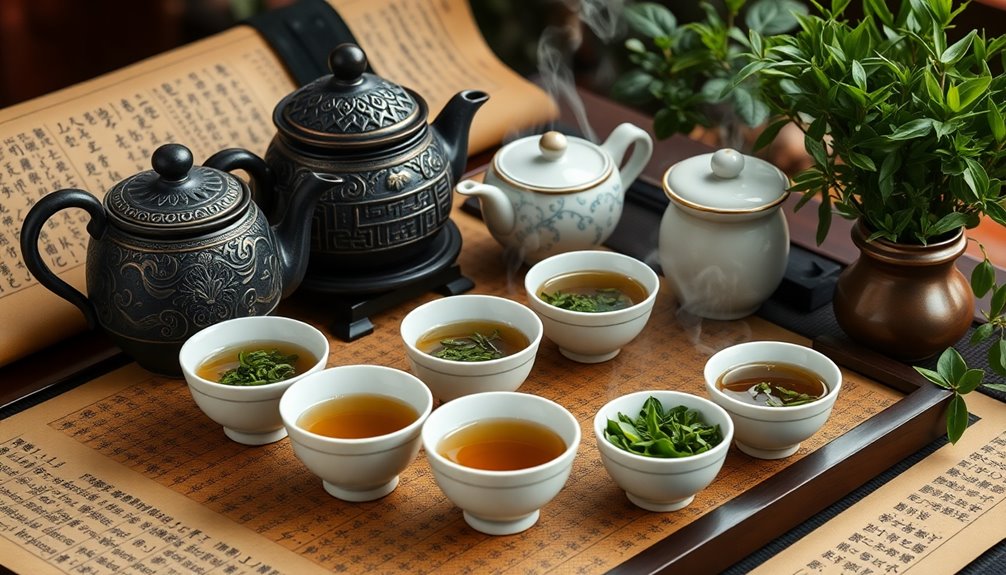
Exploring the practical applications of tea reveals its versatility beyond just a beverage. You can delve into various tea preparation methods, from the traditional Chinese Gongfu Cha to the Japanese Chanoyu, where ritual and aesthetics play crucial roles. Additionally, many tea enthusiasts incorporate aromatherapy oils to enhance the sensory experience of their tea rituals. Rooibos tea, known for its health benefits, is often enjoyed in various creative culinary applications, such as pairing with essential oils to amplify its soothing properties.
If you prefer something quicker, the introduction of tea bags in the early 20th century offered a convenient way to enjoy tea without sacrificing flavor.
As you explore regional diversity, you might find Indian Masala Chai, which combines spices for a unique taste experience. Specialty tea lounges have also emerged, showcasing diverse tea options and luxurious atmospheres, elevating your tea-drinking experience.
Moreover, tea is more than just enjoyable; it’s linked to numerous health benefits, including antioxidants and relaxation properties. For instance, certain herbal teas, such as turmeric tea, are known for their anti-inflammatory effects that may enhance overall well-being.
Today, sustainability in tea cultivation has become a priority. Many brands now emphasize ethical practices to support fair trade initiatives, ensuring that your favorite brew aligns with responsible sourcing. This commitment to sustainability not only preserves the rich heritage of tea but also supports a healthier planet.
Conclusion
In exploring the rich history of tea, you’ve uncovered its deep cultural significance and the surprising ways it shaped global connections. From diplomatic exchanges to the shadows of colonial exploitation, tea’s journey reflects humanity’s complexities. As you sip your next cup, remember it’s more than just a beverage—it’s a legacy that links continents and eras. By appreciating tea’s story, you embrace a world of traditions and shared experiences that continue to thrive today.

